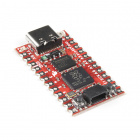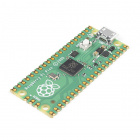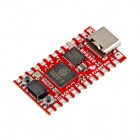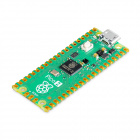Back in August, Raspberry Pi launched the Raspberry Pi Pico 2 with the onboard RP2350 microcontroller. At the same time, SparkFun came out with the SparkFun Pro Micro – RP2350. Both sold out quickly and it took some time to get them back in stock. Now that we have healthy stock of both the Pico 2 and the Pro Micro – RP2350 we thought we’d go through the technical differences between Raspberry Pi’s RP2350 and its predecessor, the RP2040.

Overview of the RP2040
The RP2040 chip, introduced in January of 2021 alongside the original Raspberry Pi Pico, was a groundbreaking entry into the microcontroller market by Raspberry Pi. It featured:
- Dual-core ARM Cortex-M0+: Operating at 133 MHz, the RP2040 provided ample power for a variety of embedded applications.
- 264kB of SRAM: Sufficient memory for lightweight applications and real-time tasks.
- 2MB of Flash memory: Provided ample storage for most embedded projects.
- 30 GPIO Pins: Including programmable IO (PIO) for flexible, custom peripherals.
- USB 1.1 Device and Host Support: Allowing for basic connectivity options.
- 2 × Programmable IO (PIO) blocks, 8 state machines total: Enabling custom peripheral implementations such as SD Card and VGA.
These features made the RP2040 an excellent choice for hobbyists and professionals alike, offering an affordable platform for a wide range of applications.
See Full RP2040 Datasheet
Products offering the RP2040

SparkFun Pro Micro – RP2040
DEV-18288
3

Raspberry Pi Pico
DEV-17829
3
Overview of the RP2350
The RP2350, the heart of the Raspberry Pi Pico 2, builds upon the strengths of the RP2040 while introducing several enhancements:
- Dual ARM CortexM33 and Hazard3 RISC-V Processors at 150 MHz: A significant boost in clock speed, offering improved performance for more demanding applications. Users can select two processors to run on boot.
- 520kB of SRAM: An increase in memory, supporting more complex operations and larger datasets.
- Up to 16 MB of external QSPI flash/PSRAM: Accessible via optional second chip-select catering to applications that require more extensive codebases or data logging.
- 30-48 GPIO Pins (depending on model): Expanding the I/O options, offering more flexibility in interfacing with external hardware.
- 12 Programmable IO (PIO) state machines: Increasing the number of custom peripheral implementations that can be run simultaneously.
- Optional RISC-V Cores: Unique to the RP2350, users can choose between dual ARM Cortex-M33 cores and dual Hazard3 RISC-V cores, offering flexibility in architecture choice.
- Advanced Security Features: Includes Arm TrustZone for Cortex-M, signed boot, 8kB of antifuse OTP for key storage, SHA-256 acceleration, a hardware TRNG, and fast glitch detectors, providing robust security options for professional-grade applications.
The RP2350’s advanced security features and dual-core, dual-architecture capability highlight its suitability for professional and industrial applications, while still retaining the accessibility and affordability that made the original Raspberry Pi Pico so popular.
See Full RP2350 Datasheet
Products offering the RP2350

SparkFun Pro Micro – RP2350
DEV-24870
5

Raspberry Pi Pico 2
DEV-26124
1
Key Differences
To provide a clearer view of the advancements, here’s a comparison table highlighting the main differences of the RP2040 and RP2350 chips:
| Feature | RP2040 | RP2350 |
|---|---|---|
| Processor | Dual-core ARM Cortex-M0+ at 133 MHz | ARM® Cortex® M33 processors and two Hazard3 RISC-V processors at 150 MHz (user-selectable for dual-cores) |
| SRAM | 264kB | 520kB (in 10 banks) |
| Internal Flash Memory | 2MB | 0/2MB (model dependent) |
| GPIO Pins | 30 | 30—48 |
| USB Support | USB 1.1 Device and Host | USB USB 1.1 controller and PHY, with host and device support |
| Programmable IO (PIO) | 8 state machines | 12 state machines |
| Security Features | No security features | Arm TrustZone, signed boot, 8kB antifuse OTP, SHA-256 acceleration, hardware TRNG, glitch detectors |
Performance and Security Implications
The increase in clock speed from 133 MHz to 150 MHz in the RP2350 translates to a noticeable performance boost, particularly beneficial in real-time applications. The optional RISC-V cores offer flexibility in processing architecture, catering to various application needs. Additionally, the enhanced security features make the RP2350 suitable for applications requiring robust protection against tampering and unauthorized access.
Conclusion
The RP2350 chip offers significant upgrades over the RP2040, making it a strong candidate for more demanding embedded applications. Whether you’re developing a new project or looking to upgrade an existing one, the enhancements in performance, memory, I/O options, security, and architectural flexibility make the Raspberry Pi Pico 2 a compelling choice moving forward.








